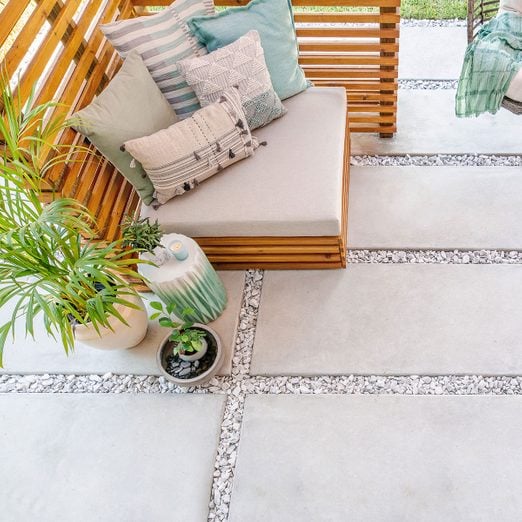How to Build and Pour Your Own Modern Concrete Patio
Multiple Days
Intermediate
$501-1000
Introduction
Not a concrete professional? Not a problem! This project is easy on beginners and leaves you with a sharp, stylish patio you'll be proud of.Tools Required
- Circular saw or miter saw
- Drill
- Hand Edging Tool
- Hard Trowel
- Magnesium float
Materials Required
- 1-by stakes
- 2x4s
- Concrete
- Decorative Rock
- Landscape Edging
- Rebar
- Rebar Chairs
- Sand
This patio design is not only stylish but also perfect for someone with limited concrete experience. It’s much more forgiving than a big, continuous slab. On a large slab, a mistake in the form or in finishing can lead to depressions and water puddles. And inadequate base prep can lead to cracking. This segmented design makes those problems much less likely. To complete the look, you add decorative rock between the pavers. Are you ready to take it on? If you have help, you can build this patio in a weekend!
Project step-by-step (13)
Prep the Site
- Remove any existing sod, giving yourself a little extra room around the edges to make it easier to place the form and screed the concrete.
- Scrape, rake and shovel the patio area to make it as level as possible. Depending on the grade and the finished height of your patio, you may need to add some sand fill.
- Lay out the patio’s footprint with stakes and string. Make sure all the math works out and that the footprint is square.
Build the Forms
- Assemble the form in sections.
- Stake the forms in place using 1-by stakes between the 2x4s. The stakes created a gap to get the width we wanted, and we also used them to level the forms.
Level the Form
- Lift and adjust the form to make it level, then screw it to the stakes. Once you’re satisfied, cut the stakes flush with the top of the form.
- Pro tip: We left the gaps open between the 2x4s, realizing too late that they’d fill with concrete. This made it difficult to remove the forms after the concrete was set. To avoid that, we recommend covering the gaps with duct tape before pouring. Also, fill in sand up to the bottom of each individual paver space so the concrete doesn’t flow underneath the form, filling the gaps from below.
Set and Tie Rebar
- Lay a rebar grid in each cavity, tying the intersections.
- Set the rebar grids on specially made “chairs” to elevate the rebar into the slabs.
Oil the Forms
- Spray or brush the forms with kerosene, diesel fuel or cooking oil. This makes it easier to remove the forms after the concrete has set.
Fill the Forms
- Fill each form, starting in the corner closest to the house.
- Pro tip: The easiest way to do this is to hire a pump truck. The hose is heavy, but not nearly as much work or headache as trying to run a wheelbarrow over the grid. We used fiber-reinforced concrete to ensure these slabs won’t crack.
Ready-Mix vs. You-Mix Concrete
We built forms, ordered ready-mix concrete and poured the entire patio at once. If that’s too daunting, you can build one or two small form sections and pour them individually at a more leisurely pace. If you choose that route, consider buying a portable mixer and selling it when you’re done.
You won’t save money mixing it yourself, though. Using 80-lb. bags of mix, it’ll cost you about $200 per cubic yard. We hired a pump truck for $180 and included fiber reinforcement in the mix, and our total price came to $116 per cubic yard. This project took just over four yards, so ordering ready-mix concrete was a great deal cheaper than mixing it ourselves.
Screed the Concrete
- Have a helper screed each section after it’s filled.
- Our patio is large, and pouring the forms progresses quickly, so a crew of four is best to perform all the tasks before the concrete sets.
- Pro tip: The person doing the screeding should be limber, as they’ll likely end up crawling around on the form grid a bit no matter how well you’ve planned the process.
‘Float’ the Surface
- After the bleed water has disappeared, float each section with a magnesium float. Floating embeds coarse aggregate particles and smooths the surface without sealing it.
- Pro tip: Before our concrete set up too much, we measured for the post anchors and installed them for the pergola.
Round the Edges
- Once the concrete begins to stiffen, start rounding over the edges of the pavers with a special edging tool. You’ll need to move quickly — there’s a lot of edging to be done!
Trowel the Concrete
- When you’re able to kneel on knee boards on the concrete and only leave a 1/8-in.- to 1/4-in.-deep indentation, start troweling the pavers. Troweling makes the surface hard, dense and smooth.
- Pro tip: Put a little “spring” in the trowel to increase that effect and feather out the transition created by the edger.
Remove the Forms
- After the concrete has cured, back the screws out of the leveling stakes and start prying out the forms.They should come out fairly easily.
- Pro tip: If you need to use a hammer and pry bar, take care not to damage the concrete. If the forms are stubborn, run a reciprocating saw around each paver before pulling the forms.
Fill the Gaps
- Install landscape edging around the patio perimeter.
- We used Permaloc ProSlide Commercial Grade Landscape Edging, which cost about $2 to $5 per linear foot.
- Using a shovel and broom, fill the spaces between the pavers with your choice of gravel or decorative rock.












